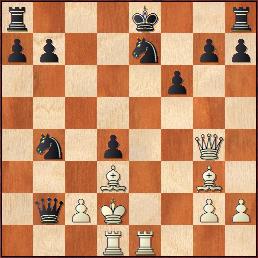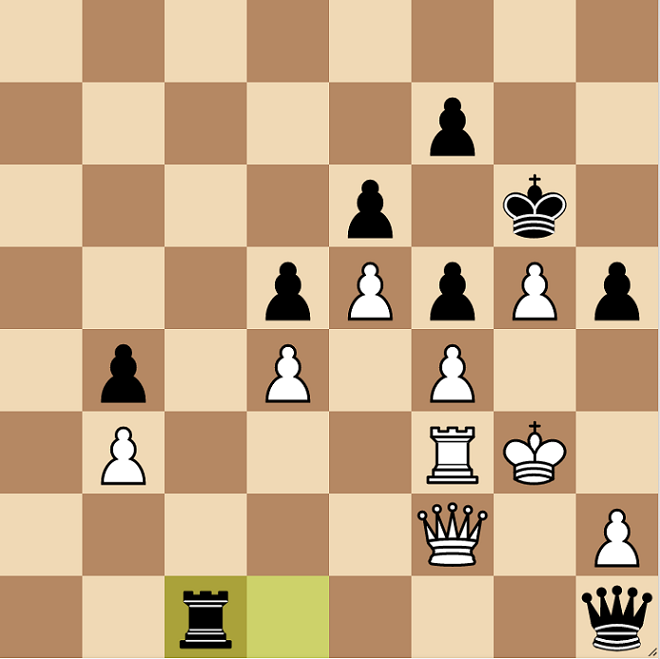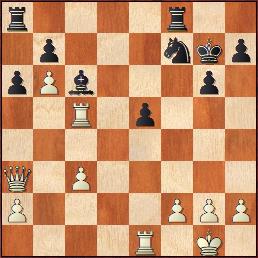Gens Una Sumus!
Newsletter #984
September 4, 2021
Table of Contents
- TNM Starts Tuesday
- ThNM Report
- Chess and Body Language
- Tony's Teasers
- Events/Class Schedule
- FM Paul Whitehead's Column
- GM Nick de Firmian's Column
- Submit your piece or feedback
Tuesday Night Marathon Begins Tuesday September 7
The next Tuesday Night Marathon live at the Mechanics' Institute begins this coming Tuesday, September 7. Register now to play in this 2-section 7-round FIDE rated event, with a time control of G/120;d5. Sections based on USCF rating; 1800+ and under 1800. Click HERE to register. For full tournament information, click on our event page here: https://www.milibrary.org/chess-tournaments/tuesday-night-marathon-2021-sep-oct-person.
We will broadcast the top 10 boards live on our Twitch channel starting at 7pm PDT with commentary by GM Nick de Firmian and FM Paul Whitehead. Follow our channel by going to this link: https://www.twitch.tv/mechanicschess
We look forward to seeing everyone on Tuesday, live from downtown San Francisco!
Thursday Night Marathon Report
by Abel Talamantez
Rounds 1 and 2 of the Thursday Night Marathon are complete, and the four titled players in the tournament crusied through the first couple of rounds unscathed, though Stewart Katz did put forth an applaudible resistance in round 2 against GM Gadir Guseinov. GM Guseinov, IM Bala Chandra Dhulipalla, FM Ezra Chambers, and FM Max Gedajlovic move into next week with 2/2, along with expert Sheel Dandekar. We must give a shoutout to Austin Jin, who was the first to provide an upset with his first round win against Robert Smith. There should be exciting clashes over the next two weeks, as the top players in the tournament will play each other, and we will find out if any of the remaining titled players can find a way to unseat Guseinov from ThNM supremacy. I would be remiss if I didn't give a special shoutout to Judit Sztaray and Victor Beauchamp for providing an action packed extra rated game in round 2, which was followed with excitement on our live broadcast. You can watch it now here:
Tune in next Thursday at 7:00pm PDT for rounds 3&4 of the Thursday Night Marathon online on our Twitch channel: https://www.twitch.tv/mechanicschess
Watch the broadcast from Thursday here: https://www.youtube.com/watch?v=gH1KgpInmcY
Here are couple of games from Thursday night, annotated by GM Nick de Firmian
(1) FM Ezra Chambers 2314(SelfishShellfish) - Casimir Dudek 1649 (Thechesskid2021) [B31]
Live Chess Chess.com
1.e4 c5 2.Nf3 Nc6 3.Bb5 g6 4.0-0 Bg7 5.Re1 Nf6 6.e5 Nd5 7.Nc3 Nc7! [7...Nxc3 8.dxc3 0-0 9.Bg5 Is simply a pleasant opening for White] 8.Bxc6 dxc6 9.Ne4 b6!?
 |
 |
 |
 |
(2) Victor Beauchamp 889 (Greatboomer) - Judit Sztaray 807 (JuditSztaray) [C29]
Live Chess Chess.com
Our tournament director, Dr. Judit Sztaray, decides she will try to play a game while directing to make games for everyone entered. A challenging task! 1.e4 e5 2.Nc3 Nf6 3.f4 The Vienna Game is an old but classic opening which can give the opponent unexpected difficulties. 3...exf4 [3...d5! is the easiest plan for Black here] 4.e5 Ng8 5.Nf3 d6 6.d4 Bg4 7.Bxf4 dxe5 8.Bxe5
 |
 |
 |
 |
 |
Two connected passed pawns up is a win. Judit shows good technique. 40.Rf1 Ke5 41.Kb3 Rg3+ 42.Kc2 f5 43.Kd2 f4 44.Ke2 Ke4 45.Ra1 Rg2+ 46.Kf1 Rh2 47.Ra4+ Kf5 48.Kg1 Rh4 49.Kf2 Rh2+ 50.Kg1 [50.Kf3 g4#] 50...Rc2! 51.Ra5+ Kg4 52.Ra3 f3 53.Kf1 Kg3 54.Re3 g4 55.Ke1 Kg2 56.Re4 f2+ 57.Kd1 Ra2 58.Rxg4+ Kf3 59.Rg1 fxg1Q# 0-1
Here are the standings after 2 rounds:
SwissSys Standings. September 2021 Thursday Night Marathon Online: Open
| # | Name | Handle | ID | Rating | Rd 1 | Rd 2 | Total |
| 1 | Gadir Guseinov | gguseinov | 17343590 | 2563 | W14 | W7 | 2.0 |
| 2 | Bala Chandra Prasad Dhulipalla | Swarnapuri | 30100858 | 2475 | W15 | W10 | 2.0 |
| 3 | Ezra Chambers | Selfishshellfish | 15191101 | 2314 | W16 | W11 | 2.0 |
| 4 | Max Gedajlovic | MMSanchez | 14947382 | 2264 | X19 | W12 | 2.0 |
| 5 | Sheel Dandekar | sdandek | 12604772 | 2034 | W17 | W13 | 2.0 |
| 6 | Austin Jin | austinjin666xd | 17144712 | 1318 | W8 | D9 | 1.5 |
| 7 | Stewart Katz | knvsback | 12458563 | 1856 | W21 | L1 | 1.0 |
| 8 | Robert Smith | maturer | 12463327 | 1853 | L6 | W20 | 1.0 |
| 9 | Kevin M Fong | chessappeals | 17254586 | 1750 | D20 | D6 | 1.0 |
| 10 | Matthew Chan | hip_hop_99 | 12541333 | 1658 | W22 | L2 | 1.0 |
| 11 | Casimir Dudek | thechesskid2021 | 30101045 | 1649 | W23 | L3 | 1.0 |
| 12 | Bryan Hood | fiddleleaf | 12839763 | 1574 | W18 | L4 | 1.0 |
| 13 | James Hamlett | James_Hamlett_IV | 12374510 | 1561 | W24 | L5 | 1.0 |
| 14 | Joseph Flowers | CoachJoeF | 12691490 | 1494 | L1 | W21 | 1.0 |
| 15 | Aaron Craig | aaroncraig602 | 12872385 | 1451 | L2 | W22 | 1.0 |
| 16 | Jimolee Gray | jgray43 | 30172836 | 1442 | L3 | W23 | 1.0 |
| 17 | Katherine Sunny Lu | 2Nf31-0 | 16425316 | 1390 | L5 | W24 | 1.0 |
| 18 | Victor Beauchamp | Greatboomer | 30154650 | 889 | L12 | B--- | 1.0 |
| 19 | Charles James | chuckchess | 12448028 | 1426 | F4 | H--- | 0.5 |
| 20 | Ian Liao | victor6688 | 16738735 | 1161 | D9 | L8 | 0.5 |
| 21 | Stephen Sikes | Raindog2 | 13058987 | 1339 | L7 | L14 | 0.0 |
| 22 | Bruce Hedman | Bruce_Hedman | 17344551 | 1087 | L10 | L15 | 0.0 |
| 23 | Rehaan Malhotra | MrRap9 | 30118209 | 1055 | L11 | L16 | 0.0 |
| 24 | Francisco Ostolaza | ostolaza4 | 30266747 | unr. | L13 | L17 | 0.0 |
SwissSys Standings. September 2021 Thursday Night Marathon Online: Extra Games
| # | Name | Handle | ID | Rating | Rd 1 | Total |
| 1 | Judit Sztaray | juditsztaray | 14708926 | 807 | W2 | 1.0 |
| 2 | Victor Beauchamp | Greatboomer | 30154650 | 889 | L1 | 0.0 |
Chess and Body Language
by Abel Talamantez
Body language can tell you a lot, sometimes even more than words could say. For being such a quiet sport, chess is a game where players often cannot control the raw emotion going on inside them, outwardly reflecting in their posture at the table. We can sometimes know how a game is going simply by looking at how a player is seated at their table. In this new series installment, we chess players will poke some fun at ourselves by looking at the body language of a player while seeing the corresponding chess position. As chess players, we know this too well, and we all understand. That is what makes this entertaining, and is done with the highest respect to all players.


In this game from the Bernardo Smith Memorial, Alan Finkelstein is playing black against eventual tournament winner FM Baasansuren Erdene. Finkelstein had a solid tournament, scoring 3.5/5 in a tough open section. In this 2nd round game however, a slumped Finkelstein reveals things may not have been going so well. Can anyone guess by looking at the position on the board and the body language the computer analysis advantage for white? The answer at the end of the newsletter.
Tony's Teasers
Tony challenges you to solve this problem, white to move and mate in 3.


Mechanics' Institute Events Schedule
Don't Miss our Exciting Upcoming Events!!
The Mechanics' Institute will continue to hold regular and online events. Here is our upcoming schedule for players:
Mechanics' Institute September ThNM Online. September 2-September 16, 6:30PM PT. 6 Games G/35+5: https://www.milibrary.org/chess-tournaments/thursday-night-marathon-online-sep-2021
Mechanics' Institute September/October TNM: FIDE Rated. September 7-October 19, 6:30PM PT. Games G/120;d5: https://www.milibrary.org/chess-tournaments/tuesday-night-marathon-2021-sep-oct-person
Mechanics' Institute August Quads: September 11, 3PM PT. 3 Games G/30;d5: https://www.milibrary.org/chess-tournaments/mechanics-championship-quads
20th Howard Donnelly Memorial Championship: FIDE Rated. September 18-19, 9AM PT. 5SS G/120;d5: https://www.milibrary.org/chess-tournaments/20th-donnelly-memorial-championship-person-fide-g120d5
Mechanics' Institute Class Schedule
Click HERE to see our full slate of specialty chess classes, we offer something for everyone!
Scholastic Bulletin
The scholastic news will be covered in a dedicated publication:
Scholastic Chess Bulletin
Scholastic Bulletin #4 is out!
Please click the following LINK to read our latest edition.
All of us at Mechanics' Institute would like to thank you for your support of our scholastic chess programming.
FM Paul Whitehead's Column
[email protected]
Aron Nimzowitsch and the Three Zugzwangs
Aron Nimzowitsch (1886 - 1935) was a fascinating individual, well known for his eccentric (and quite sound) ideas in chess. My System and Blockade both authored in 1925, were followed by Chess Praxis in 1929. An original voice and playing style had risen to the top of the chess world, and although he couldn’t quite crack through the Lasker/Capablanca/Alekhine trifecta, he was among the very best players of his day.
Concepts like over-protection, blockade and prophylaxis were coined and codified by this Latvian born and Danish naturalized citizen, and chess titans Bent Larsen and World Champion Tigran Petrosian counted themselves as his disciples.
----------
As a chess player I am fascinated by certain patterns that arise in that world, where a player repeatedly finds himself in certain situations. Why does Viswanathan Anand like the Knights, while Bobby Fischer favored the Bishops? How come Geza Maroczy was the greatest Queen endgame player who ever lived? What makes Petrosian march his King all over the board, and why was Mikhail Botvinnik hell-bent on crashing through the center?
Seeing these themes repeated endlessly, I hope to find the patterns that increase my own understanding.
----------
In 1923 Nimzowitsch conducted the “Immortal Zugzwang Game”, tying up his opponent Friedrich Saemisch in knots and forcing his helpless opponent to resign with the board full of pieces on the 25th move. It was zugzwang on the board, and in case you are unfamiliar with the concept here is the simplest example, with black to move:

The word comes from German Zug 'move' + Zwang 'compulsion', so that Zugzwang means 'being forced to make a move'. (Wikipedia).
Black MUST play 1…Kd7 allowing white to force a new queen with 2. Kf7 and wins,
etc.
----------
Here is the “Immortal Zugzwang Game”. Annotating the game in My System, Nimzowitsch gives himself a double-exclamation mark after 25…h6!!
and concludes: “A brilliant move that announces the zugzwang. White has not a move left. If, e.g., Kh2 or g4, then R5f3. Black can now make waiting moves with his king, and White must, willy-nilly, eventually throw himself upon the sword”.
Friedrich Saemisch – Aron Nimzowitsch, Copenhagen 1923.
Queen’s Indian Defense
1. d4 Nf6 2. c4 e6 3. Nf3 b6 4. g3 Bb7 5. Bg2 Be7 6. Nc3 O-O 7. O-O d5 8. Ne5 c6 9. cxd5 cxd5 10. Bf4 a6 11. Rc1 b5 12. Qb3 Nc6 13. Nxc6 Bxc6 14. h3 Qd7 15. Kh2 Nh5 16. Bd2 f5 17. Qd1 b4 18. Nb1 Bb5 19. Rg1 Bd6 20. e4 fxe4 21. Qxh5 Rxf2 22. Qg5 Raf8 23. Kh1 R8f5 24. Qe3 Bd3 25. Rce1 h6 0-1.

----------
A great game, and a beautiful illustration of Zugzwang.
But now we come to one of those strange conundrums, those unexplained mysteries, for it came to pass that Nimzowitsch himself fell victim to a masterpiece of the Zugzwang theme: not once, but twice!
----------
The first time was to a model squeeze by Capablanca, the standing World Champion at the time.
Aron Nimzowitsch – Jose Capablanca, New York 1927.
Caro-Kann Defense
1. e4 c6 2. d4 d5 3. e5 Bf5 4. Bd3 Bxd3 5. Qxd3 e6 6. Nc3 Qb6 7. Nge2 c5
8. dxc5 Bxc5 9. O-O Ne7 10. Na4 Qc6 11. Nxc5 Qxc5 12. Be3 Qc7 13. f4 Nf5
14. c3 Nc6 15. Rad1 g6 16. g4 Nxe3 17. Qxe3 h5 18. g5 O-O 19. Nd4 Qb6 20. Rf2 Rfc8 21. a3 Rc7
22. Rd3 Na5 23. Re2 Re8 24. Kg2 Nc6 25. Red2 Rec8 26. Re2 Ne7
27. Red2 Rc4 28. Qh3 Kg7 29. Rf2 a5 30. Re2 Nf5 31. Nxf5+ gxf5 32. Qf3 Kg6 33. Red2 Re4 34. Rd4 Rc4 35. Qf2 Qb5 36. Kg3 Rcxd4 37. cxd4 Qc4 38. Kg2 b5 39. Kg1 b4 40. axb4
axb4 41. Kg2 Qc1 42. Kg3 Qh1 43. Rd3 Re1 44. Rf3 Rd1 45. b3 Rc1.

Zugzwang!
46. Re3 Rf1 0-1.
A game played and won in the style of Aron Nimzowitsch himself!
----------
And then, three years later, incredibly, another classic loss to another standing World Champion. This game seems remarkably like the victory over Saemisch in that the Zugzwang occurs in the middle-game, and features the famous “Alekhine’s Gun” theme as well, with the Queen backing up the doubled-Rooks:
Alexander Alekhine – Aron Nimzowitsch, San Remo 1930.
French Defense
1. e4 e6 2. d4 d5 3. Nc3 Bb4 4. e5 c5 5. Bd2 Ne7 6. Nb5 Bxd2+ 7. Qxd2 O-O 8. c3 b6 9. f4 Ba6 10. Nf3 Qd7 11. a4 Nbc6 12. b4 cxb4 13. cxb4 Bb7 14. Nd6 f5 15. a5 Nc8 16. Nxb7 Qxb7 17. a6
Qf7 18. Bb5 N8e7 19. O-O h6 20. Rfc1 Rfc8 21. Rc2 Qe8 22. Rac1 Rab8 23. Qe3 Rc7 24. Rc3 Qd7 25. R1c2 Kf8 26. Qc1 Rbc8 27. Ba4 b5 28. Bxb5 Ke8 29. Ba4 Kd8 30. h4 1-0.

Zugzwang! As you can work out for yourself.
----------
This leaves us with the (perhaps) unanswerable mystery: just what was it about Nimzowitsch and Zugzwang? Like so many patterns and connections one sees in chess, this kind of question both puzzles and mesmerizes, prompting yet more investigations…
GM Nick de Firmian's Column
Bobby Fischer and His World
The games of the World Champions are always of great interest to club and tournament players. They keep their appeal through time as we love to look back and see what ideas they discovered to advance the game of chess and conquer all other players of their time. We see in Paul’s writings for this newsletter the wonderful examples of the champions 100, 80 or 60 years ago. Someone who has been a living inspiration to many of our veteran chess players is Bobby Fischer – but Fischer’s career is now so long ago that he is being relegated to a “historical” world champion. His delightful games are still very instructive and entertaining to see, yet we place him now alongside Capablanca, Botvinnik and Alekhine.
There is no better way to learn of the career of Bobby Fischer than reading John Donaldson’s tome “Bobby Fischer and His World.” This 642-page work is comprehensive to say the least. If you miss hearing the entertaining stories that our former MI chess director would tell you on Tuesday evenings (before the TNM games) then you definitely want to read his book. John covers the development of Fischer as a boy so we see how he developed his game in the early years. We give below first a game which developed the young Fischer, a loss to Viktors Pupols in a US Junior Championship. Viktors though is still playing touraments and one of the dwindling living connections to the glorious Fischer times.
We are most interested though to see the games when Fischer became superman, and mercilessly crushed all opposition. Bobby played many superb and forceful games from the late 50’s to his capture of the chess throne in 1972. We give a couple of those below. Many more wonderful Fischer creations are in John Donaldson’s book, along with a lot of the stories told in John’s engaging style.
(1) Fischer,Robert James - Pupols,Viktors [C40]
USA-ch U18 USA, 1955
1.e4 e5 2.Nf3 f5 The Latvian Gambit! Victors shows his heritage with this opening. 3.Nxe5 Qf6 4.d4 d6 5.Nc4 fxe4 6.Nc3 Qg6 7.Ne3 Nf6 8.Bc4 c6!
 |
 |
(2) Fischer,Robert James - Reshevsky,Samuel Herman [B35]
USA-ch New York (6), 1958
Very soon though Fischer showed he was a major talent. At just 15 years old he smashes one of the best players in the country. 1.e4 c5 2.Nf3 Nc6 3.d4 cxd4 4.Nxd4 g6 5.Nc3 Bg7 6.Be3 Nf6 7.Bc4 0-0 8.Bb3 An Accelerated Dragon, which should transpose into a normal Dragon with 9...d6. Reshevsky though decides to chase down the light-squared bishop and runs into tactics. 8...Na5? 9.e5!
 |
 |
 |
 |
(3) Robert James Fischer - Pal Benko [B09]
US Championship 1963/64 New York, NY USA (10), 30.12.1963
Soon Fischer became dominant in the US and was headed for the chess crown. He would make mincemeat of strong grandmasters. 1.e4 g6 2.d4 Bg7 3.Nc3 d6 4.f4 A great opening player, Fischer would always choose sharp, aggressive variations. 4...Nf6 5.Nf3 0-0 6.Bd3 Bg4 7.h3 Bxf3 8.Qxf3 Nc6 9.Be3 e5 10.dxe5 dxe5 11.f5!
 |
 |
White to move and win 19.Rf6!! Blocking the advance of the f-pawn. 19...Bxf6 20. e5 will be mate on h7. 19...Kg8 20.e5 h6 21.Ne2 simple and crushing. If 21...Bxf6 22. Qxh6 mates. If the knight on d6 moves then Qf5 mates. So White wins a clear piece. Benko resigned. 1-0
Body Language Analysis
Depending on the engine, but this particular body language means a 1.72 disadvantage for black.
Solution To Tony's Teaser
1. Of8!! Qxf6 2. Bc7 Be5 3. Qb4#
1. Qf8!! Ne6 2. Qd6+ Qe5 3. Nh5#
Submit your piece or feedback
We would welcome any feedback, articles or "Letter to the Editor" piece. Submit yours today through this Google Form:
You can browse through our archived newsletters using the "next" and "previous buttons".
Want to save this newsletter for reading at a later time? Click here to learn how.
Want to be notified when the next newsletter is published? Join Our Email List →
